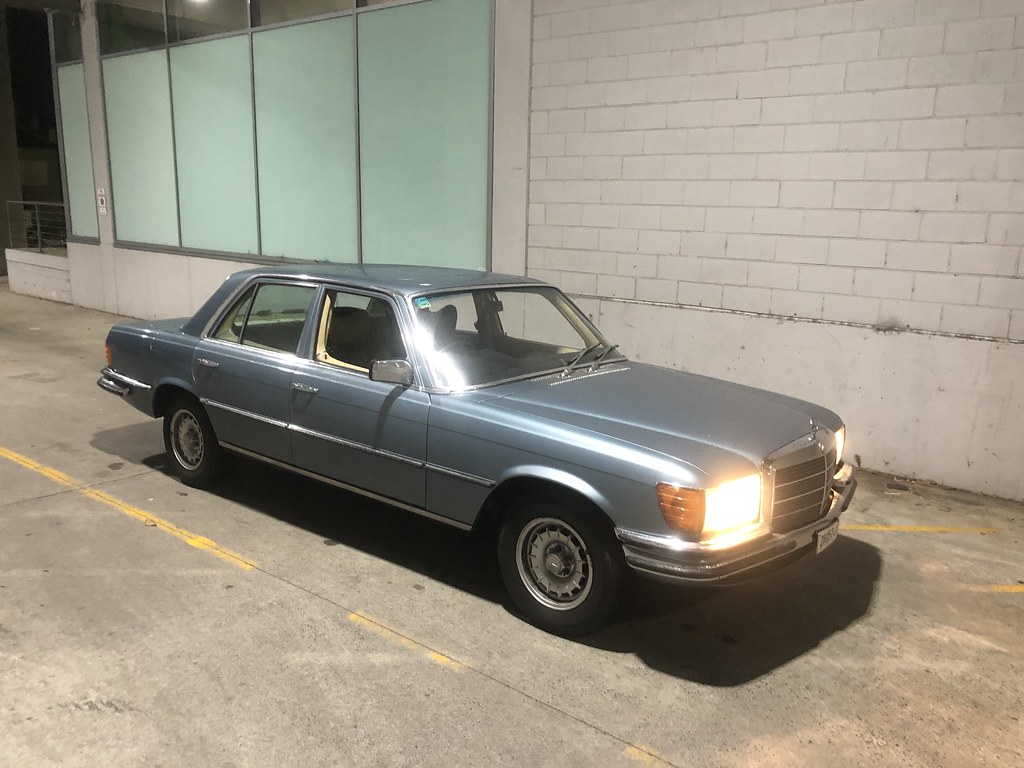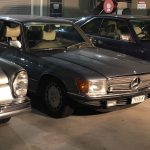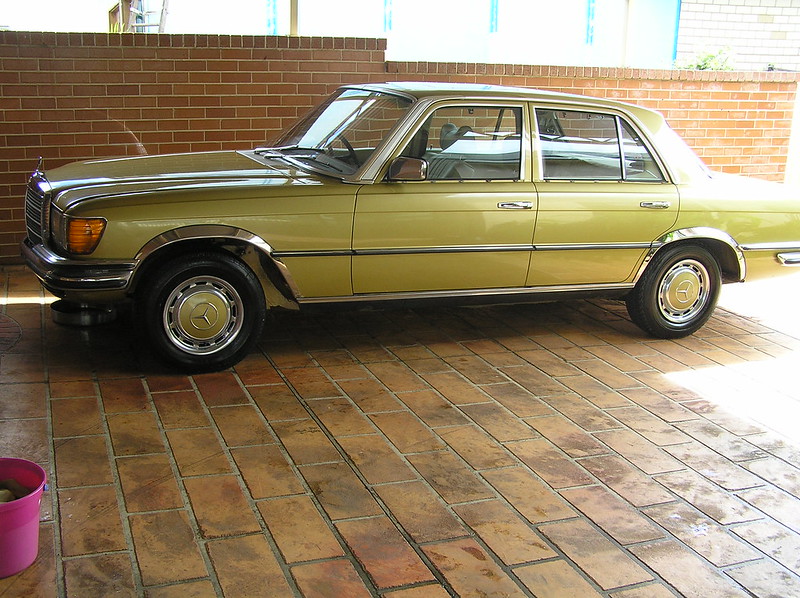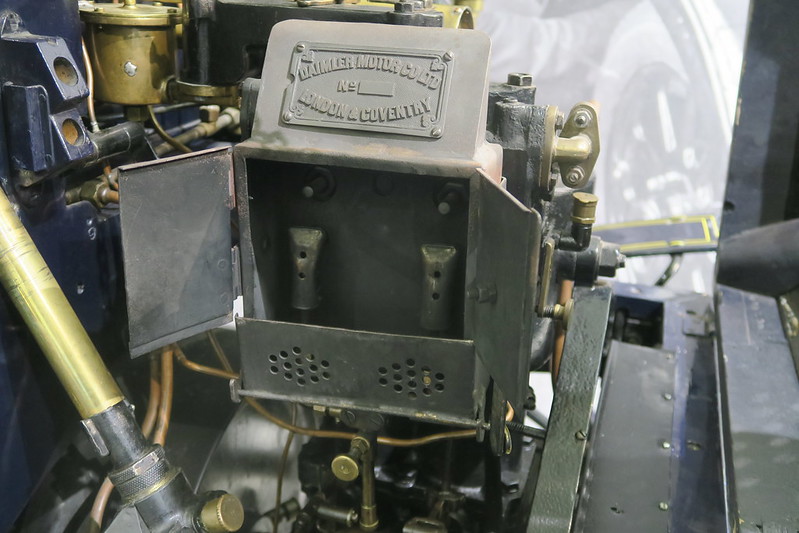The W116 Mercedes is no longer a common sight on the roads of Australia. Yet, at one time, it was quite prevalent. With a 450SEL costing more than 8 times an equivalent Holden it was a very expensive car. Despite that, it was a strong seller with little real competition. The closest competition was probably from Jaguar – but they were much cheaper, and the 70s was the nadir of Jaguar’s quality. Rolls Royce was in a league of its own, and BMW were really only competitive with small sports saloons.
The W116 was on sale during a tumultuous time for cars in Australia. Auto manufactures were grappling with increased government regulation, there were multiple oil shocks and rampant inflation. Australia would introduce its own emissions regulations to take effect July 1976 – ADR27A. It would be 10 years before performance and fuel economy would regain pre 1976 levels. While ADR27A was well meaning, in reality it just swapped one emission for another – small reductions in NOx and CO were exchanged for higher fuel consumption and CO2 emissions.
W116 model changes
ADR27A means that the W116 in Australia can be split into two distinct groups – those subject to ADR27A and those not. That split generally coincided with the change from Bosch D-Jetronic to K-Jetronic for the fuel injected models. It also made a distinct difference between Australian delivered cars and private imports. Once ADR27A came into effect, versions for Australia were quite specific and Mercedes-Benz Australia only imported a subset of their range. In the past, most of the range was available, albeit with a delay between introduction and arrival in Australia.
The first W116s would arrive on Australian shores in early 1973. These were the 280S, 280SE and 350SE. They would be joined by the 450SE and 450SEL in July, although the 450 models were not available in volume until 1974. 1974 also had the heated rear screen added to the standard specification. As with the other models, the 280SEL and 350SEL would join the Australian range a year or so after introduction in global markets. These models would continue until the introduction of ADR27A – which applied to any car manufactured after 1 July 1976. With shipping time, D-Jet models were still being delivered in 1976.
The ADR27A range would be much smaller. Initially it was focused on the K-Jetronic M110 and M117 engines. This meant the 280S, and both 350 models were dropped from the range. For some reason, the 280SEL was also dropped, but would be added again from the 1978 model year. It would also be November 1978 before the 450SEL 6.9 would finally reach Australian shores. The 300SD was never offered in Australia.
Not related to events in Australia, Mercedes-Benz was already planning on shifting from D-Jetronic to K-Jetronic. K-Jetronic was a simpler and cheaper system, and was much easier to get to pass the tough US emissions systems. It just so happened that these things happened at roughly the same time.
The change from D-Jetronic to K-Jetronic in world markets would have a minor performance penalty. The injected M110 engine dropped from 136KW / 238Nm to 130KW / 234Nm and the M117 would drop from 165KW / 378Nm to 160KW / 360Nm. This performance would be regained in 1978. However, ADR27A meant the Australian versions fared far worse. The M110 was particularly impacted. Always an engine that needed to rev for good performance, the reduced compression and retarded timing reduced output to 112KW / 206 Nm, less than the 280S. The M117 fared better, with a drop to 147KW / 345Nm. The 450 relied on torque, which was only slightly reduced, although the retarded timing made throttle response far worse. Unlike the world models, there would be no increase in 1978.
Despite the ADR changes, Australia fared far better than the US or Japan. A catalytic converter was required in these markets, and standards were even tougher. By 1980 the poor old 450 engine would have only 120KW in US Spec. The US models would also be saddled with impact bumpers that looked like railway sleepers.
The ADR models also coincided with the standardization of self-leveling rear suspension for all Australian models bar the 6.9 which had the full hydropneumatic system. These later Australian models also had a tachometer as standard.
For the 1978 model year, the carpet was upgraded from loop pile to velour, and full wood trim was as standard. This was Zebrano for all models, bar the 6.9 which had burl walnut. The fader also changed from a large knob to a roller switch. For 1979 the pinstripe style Becker Mexico was replaced by the black style with the large knobs. 1980 would be the final year of the W116, as the new W126 models arrived for 1981.
For the W126, the range was curtailed even further, and started with only the 280SE and 380SEL. Later, other models would be added. The W116 is unique in that it was the only S Class model until the W221 to offer the larger standard V8 in a short wheelbase. Given the 450SE was quite popular, I’ve never understood this. The W126 also addressed one of the main criticisms of the short wheel base W116 – the lack of rear leg room. In my view, Mercedes Australia should have skipped the 380 models and imported the 500SE and 500SEL, tuned for ADR27A, performance would have still been very good.
| 1972 | 1973 | 1974 | 1975 | 1976 | 1977 | 1978 | 1979 | 1980 | |
|---|---|---|---|---|---|---|---|---|---|
| 280S | -/3,787 | ?/15,340 $13,373 | ?/20,808 $16,960 | ?/21,996 $20,655 | ?/18,031 $20,935 | -/17,080 | -/15,307 | -/9,208 | -/1,291 |
| 280SE | -/3,735 | ?/18,266 $14,274 | ?/18,634 $18,020 | ?/17,376 $21,935 | ?/17,968 $22,210 | ?/26,903 $31,940 | ?/23,571 $36,200 | ?/22,568 $41,700 | ?/1,572 $45,500 |
| 280SEL | -/1 | -/535 | ?/716 $23,800 | ?/1,042 $24,160 | -/1,295 | ?/1,662 $40,460 | ?/1,551 $43,000 | ?/270 $47,425 | |
| 300SD | -/51 | -/5,970 | -/13,194 | -/9,419 | |||||
| 350SE | -/4,353 | ?/14,340 $15,757 | ?/7,226 $19,740 | ?/5,447 $24,045 | ?/4,734 $24,230 | -/5,723 | -/4,964 | -/4,099 | -/214 |
| 350SEL | -/58 | -/529 | ?/552 $25,655 | ?/718 $25,850 | -/807 | -/911 | -/653 | -/38 | |
| 450SE | -/52 | ?/13,400 $18,951 | ?/7,579 $22,854 | ?/4,672 $27,427 | ?/5,188 $27,427 | ?/4223 $38,229 | ?/3,570 $46,383 | ?/2746 $51,454 | ?/174 $54,369 |
| 450SEL | -/24 | 98/6,930 (1.4%) $20,881 | 311/8,350 (3.7%) $25,572 | ?/6,167 $29,117 | 305/9,650 (3.2%) $29,117 | 271/10,042 (2.7%) $39,298 | 237/8,508 (2.8%) $48,502 | 277/8,217 (3.4%) $53,835 | 40/1,690 (2.4%) $56,886 |
| 450SEL 6.9 | -/474 | -/1,475 | -/1,798 | 87/1,665 (5.2%) $77,100 | 140/1,839 (7.6%) $77,100 | 1/129 (7.0%) $77,100 |
The table above outlines the models available in Australia. The entries in bold were years where that model was offered in Australia. The first number outlines Australian sales, although I only have this for 450SEL and 450SEL 6.9 models. The second number represents global production of that model. Where an Australian sales number is known, there is a percentage that indicates what part of production was sold in Australia. Finally the selling price before on road costs is represented below the production numbers. Australian sales do not exactly line up with the yearly production due to the time taken for the cars to be shipped between then West Germany and Australia. The price data is from two different sources, which generally align with a few minor exceptions.
The table illustrates a number of interesting things. Firstly, how small the Australian market was for Mercedes Benz. Secondly, how quickly prices rose through the 70s. It also appears Mercedes were trying to claw back the ADR27A engineering work as the biggest price rise was after the introduction of ADR27A. Back in the 70s, there was not as big a gap between the S class and regular models in terms of price.
Australian features
The other thing to take into account was that many things that would be standard features now, were not during the time of the W116. All Australian W116s had power steering and automatic transmissions as standard. Until ADR27A, it was possible to special order manual transmissions on the 280 and 350 models. Early 280 and 350 models could be quite spartan. crank windows, MB-Tex, no sunroof, tachometer or alloy wheels. Early 280s also had thin door trims.
Through 1974, A/C was an optional feature on the 280 and 350 models. Today, its quite unusual to find surviving cars without it. Survival rates of early cars are quite low, and a car without A/C would have had poor resale value even in the late 70s let alone the 80s or 90s. The 450 models had leather, power windows and a Becker Mexico cassette as standard, but alloy wheels an a sunroof were still extra cost items. The sunroof would be standard on the 6.9 though. For some reason, Mercedes-Australia never offered ABS in Australia on the W116, even though it was introduced in late 1978. The Becker Mexico would only be standardized on the 280 models later, around 1976. Before that, it was optional.
Private Imports
This period of time also had many private imports arriving on Australian shores. At that time, there was a fair amount of immigration from South Africa, where these cars were made locally. There was some restriction on bringing currency, but not personal possessions, so many cars arrived in Australia. These were nearly always short wheelbase 280 and 350 models. The cars made in the East London factory had a reputation as being better than those from Stuttgart. They were all short wheelbase, always with the thin door cards, but more likely to be equipped with leather and a more powerful air-conditioning system. They also had a sump guard as standard. Due to being from South Africa, they were also less likely to be affected by rust.
The other common source was UK cars, mostly higher end models to justify the shipping (e.g. 450s and 6.9s). Values of these cars plummeted in the 80s in the UK, but held up in Australia. These cars were more likely to have velour interiors and even some 450 models did not come with air conditioning. For some reason UK 450s were not equipped with a tachometer. The UK cars were highly likely to be impacted by rust, but there are still some good ones around. Some of them were even equipped with ABS.
What happened to the cars?
As well as being driven by the usual clientele of Mercedes-Benz, the W116 also did a stint as the prime ministerial car in Australia, and wore the C1 licence plate. Australia’s 21st prime minister, Gough Whitlam ordered a pair of 450SELs as the prime ministerial car in the early 70s, complete with column shifters. Mr Whitlam would remark that he would be “very happy if other office bearers in this parliament were to make do with an ordinary Holden or Valiant, but if there is going to be a graduation of cars I am going to have the best”
With the locally sold cars plus this range of private imports, there were probably at least 10,000 W116s in Australia at one point. This number would plummet over the years. Many of the cars were simply used up. They were popular as limos and for people who did big country mileages. Indeed, back in the 90s when I was buying my first W123 it was very common to see a W116 for sale in a regional centre with more than 400,000km on the clock. I’ve seen more than one with over a million kms and still running. The M110 and the iron block V8s are extremely tough engines, as are the 722.0 and 722.1 transmissions.
The same can’t be said for the bodies. The W116, is among the most rust prone Mercedes-Benz model with dreadful rust traps and multiple double skinned and triple skinned sections. It is up there with the 107 and 114/115 in this respect. Cars parked outside eventually fell victim to rust, and high parts prices meant cars were scrapped because they were uneconomical to repair. This was particularly an issue with the D-Jet cars that needed specialized skills to repair and keep running. This is a shame as those cars were better to drive.
The Mercedes-Benz dealerships also waged a disinformation campaign against private imports. Unless they were rusty, these cars were generally better, not saddled with ADR27A. The South African cars in particular were a great alternative to the aussie models, but this campaign meant values plummeted and many of those cars were prematurely scrapped.
The W116 today
Today, most of the cars left in Australia are later model, Australian delivered cars. The 6.9 is a bit of an exception to this as many private imports remain too. Given the purpose of buying a 6.9 for many was performance, the imported model was attractive for that reason. Without any data to back it up, I would guestimate there are 500-1000 cars remaining. Most of them are in average to rough condition, probably only 10% are in nice to excellent condition. Values for that 10% are slowly starting to climb, although outside of the 6.9 the W116 still remains a very cheap classic to get into.
The W116 has its group of core followers, although it still lives in the shadow of its predecessor, the W108 with its classic looks, and its successor, the W126. The W126 in many ways is a heavily facelifted W116, so for years buyers preferred it. The W116 does offer a great alternative to both. It, and the 107 was the first modern car to come out of Mercedes Benz. At the same time, it does without complex electronics and the use of plastics prevalent to the W126. The W116 retains the chrome bumpers giving a more classic look. The W126 added a lot of refinement to the model, which was welcome, but at the same time something was lost too. The W116 has a much more raw driving experience, that many prefer in a classic car.








Leave a Reply